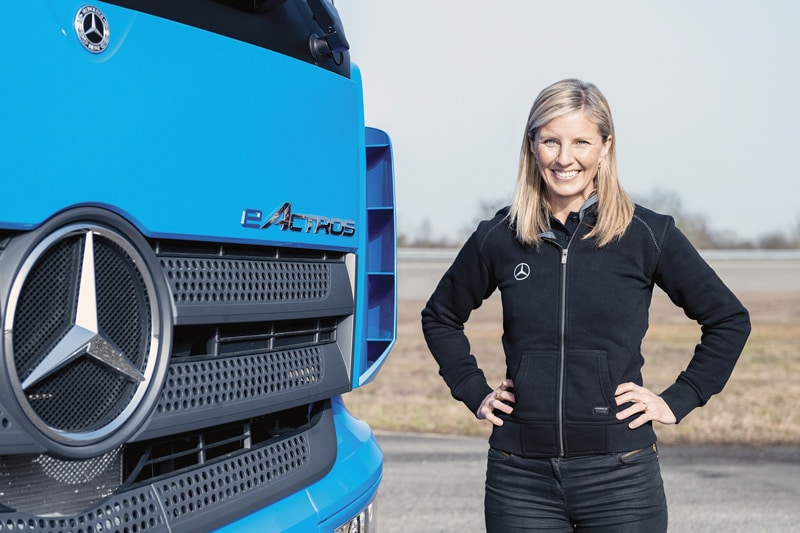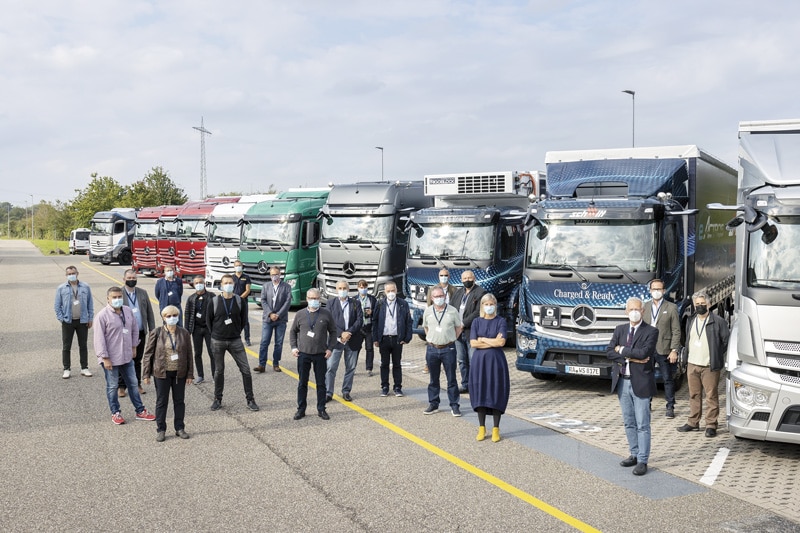Karin Rådström, Member of the Board of Management at Daimler Truck AG, responsible for the regions Europe and Latin america and the Mercedes-Benz Truck brand in an exclusive conversation with Gianenrico Griffini, Chairman, International Truck of the Year talks strategy.
Q. Last May, during the Strategy Day, Daimler Trucks set out its ambitions in the commercial vehicle business. So far, are you on track with those challenging targets in Europe and South America?
A. The long term target for Mercedes Benz trucks is to reach double-digit figures. I think that’s where we need to benchmark ourselves. And I would say, the plan towards that target, is both working on our top line and the bottom line. So to get to sell more, or to be more successful in specific segments, and to improve our service business, it’s also about reducing costs. And there we work both with personnel cost, non-personnel costs, like the indirect costs, production costs and material costs. So I think, we’re attacking more or less everything. And so far, it’s running according to the plan, We wish to do similar things in Europe and in Brazil. I would say we have a good programme in place, and we’re very closely tracking all the activities, making sure that we move them forward. Obviously, still a lot of work left to do. I would say we’re about halfway through. But I feel very confident that we’re on a good path.
Q. In particular, which plans are you implementing in Europe and South America? Are you streamlining your portfolio?
A. An overarching theme, I would say is customer focus.
One concrete example is Brazil. We are looking at our product portfolio. We have now launched SFTP Actros, we’ve gotten rid of some old products that we don’t market anymore. And we try to really focus on the ones that are demanded by the customers. In Europe, also, we’ve had a very big product portfolio, and we have streamlined it. So we have reduced the number of so-called monsters that we work with, but actually, as far as we see so far, with a very little customer impact. So it was a monster that was not demanded by the customers. And when we can get rid of that complexity, and all the costs that are related to having this big complexity including the documentation of workshop, spare parts we have to carry on with and stock. These are things we don’t necessarily even see. But we have done that job now. And I think it will also allow us to invest more into the products that we actually need. So that’s very concretely on the product side.
When you look at what we are presenting today, we want to penetrate certain segments better. And since we talked about Actros L and Actros F, obviously, long haul segments and then with the small to medium customers that’s where we’re doing a lot of activities. We think we have the potential to grow the market share of services. I mentioned, I think it’s both a huge potential in the current service business, just selling more contracts, having better parts availability that we’re working on. And also now with the new technologies, that’s an opportunity for us to be more solution-focused. In Brazil, we have a lot of potential to improve the aftersales business. So I think there are concrete actions in place to really make this transition happen. But of course, we need to keep working on it.
Q. Daimler Truck sees significant growth potential in services. How are you planning to achieve the target of an increase in revenues on the service portfolio from the current 30 per cent towards 50 per cent by 2030?
A. I think we have a lot of potential just in the traditional services. When we look at service contract penetration, we are really good in some markets and not so good in other markets. So we tried to focus on getting that up. And that usually also means that we will sell more parts and services when we have a contract. Another thing we also look at, and we now have made into one of our key KPIs is the turnover of parts and service on the 10 years rolling fleet in each market. And there, we also see that we have huge regional differences. So we’ve started working in a more structured way to see what are we doing right and say Norway, or Switzerland that we can carry over to. Denmark, in Austria, to give another example.
From a mid-term perspective, we’ve started to prepare for having a truck with dedicated parts to logistics. And I think this will be a big difference for our customers. Since today, that’s all handled through the cargo organisation, I would say sometimes the need is a bit different. Like this summer, my car broke down. I just got to borrow another one. So I don’t really care if I’m in the workshop, a couple of days. But for a truck company, that’s not always possible if it’s a very special application, and so on. So we need another level of spare parts availability. So I think that will also help our traditional service business. And then, of course, with e-mobility, and with hydrogen, we see a big potential on the ecosystem side. And then also with digital services, I think we have big potential for connectivity with the Daimler Fleetboard. We work with ‘Habbl’ for logistics and route optimisation. And also there, it’s really I would say, in the early phase, with a lot of growth potential. Then there is also predictive maintenance and financial services aspect that I am looking at with growth potential.
Q. Electrification both with BEV and FCEV vehicles is one of the main pillars of the Daimler Truck strategy in the coming years. Do you think Daimler can still achieve the 60 per cent ZEV selling volumes by 2030, despite market disturbances?
A. It’s quite well worked through, and it would make sense for more than 60 per cent of our customers to buy an electric truck instead of a diesel one. So I think, there there is a lot of work behind the TCO calculation. When you look at this calculation, it depends so much on each factor. If one factor were to change, like the price of electricity, or assumptions we make on battery prices, it can change. But I think it doesn’t really matter whether it’s 2030, or 2032. I think the direction is clear.
Q. What scenario for alternative trucks do you foresee (and prefer)? A very slow rate uptake for some years, followed by an exponential increase of volumes or, conversely, a steady, linear increase?
A. It will be based on the TCO development. And when I say TCO, I think I mean, one part of that is actually also the subsidy programmes. And I think we saw that with city buses, all of a sudden, a city is going to be emission-free. Then you don’t need to because it’s just decided. We start to see that the zero-emission zones, maybe will make certain applications transition faster, even though the pure TCO is not there. So super hard to predict, which is why I mean, I think we’re quite prepared for different scenarios. As an engineer, I like the idea of a steady increase and not this, as I call it the hockey stick curve. How we now have planned is that we will have flexibility also in our production system for different technologies.
Q. Which one of these elements makes the difference in alternative truck uptake by the market: reliable BEV/FCEV vehicles with a TCO equal (or better) than a diesel, offering the customer a complete solution portfolio, economic incentives, and availability of a suitable charging network?
A. I think it depends on what you put into the word TCO. If you look at the whole business case of the customer, I mean, we start to see already in certain applications. I actually spoke to a customer in Turkey two days ago, and they said, a company like Nike that they were driving for, is already willing to pay 20 per cent more if it’s a sustainable office, a zero-emission truck transporting. We start to see it from like the big corporate like the IKEAs and Procter and Gamble and a couple of other big ones. If this trend accelerates and I think it will, it will also be part of the TCO. So maybe it will make sense to transition faster. Our customers are very logical people and they will do the switch when it makes sense. While TCO will be the deciding factor I would also put in the price on what subsidies the customer will get access to and what will the tax on CO2 develop like? With all of this, it will be TCO driven for sure.
Also read, Daimler Truck and Cummins to cooperate



























